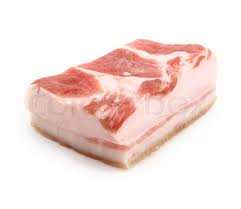 Lard. Lardy. Or as the Italians romantically refer to it: lardo. The associations with shivering rolls of chubby flesh being chased around the playground are comic yet laced with danger. Far from innocent yet not proven guilty, accusations of raising cholesterol and clogging arteries have outlawed lard to the margins of our kitchens. Instead, taking centre stage in the frying pan is lard’s sexier, slimmer (and expensiver) continental cousin- olive oil.
Lard. Lardy. Or as the Italians romantically refer to it: lardo. The associations with shivering rolls of chubby flesh being chased around the playground are comic yet laced with danger. Far from innocent yet not proven guilty, accusations of raising cholesterol and clogging arteries have outlawed lard to the margins of our kitchens. Instead, taking centre stage in the frying pan is lard’s sexier, slimmer (and expensiver) continental cousin- olive oil.
But are we doing the right thing by cutting down so dramatically on something that tastes so good? Without pork scratchings and crackling I think my life would be less pleasurable and it’s a sacrifice I have been unwilling to make thus far. My pursuit of the white stuff however, is not entirely hedonistic – I am a firm believer that it can actually be good for you.
According to food writer Oliver Thring, the average daily consumption of lard in 1974 was about 55g, now we eat only about 5g a day, roughly a teaspoon. Medical advice from the 1950s which essentially demonised saturated animal fats has meant that lard has been beaten out of our kitchens and mutated into all sorts of industrial horrors, of which margarine is probably the most abhorrent.
The good news is that opinion in some camps is shifting. According to one science journalist, only 20% of lard is ‘bad’ for you. Moreover, lard is 50% monosaturated fat, of which 90% is oleic acid, exactly the same fat that is promoted as being ‘good for you’ in olive oil and can actually lower cholesterol. The voices of dissent also claim that eating meat, and even vegetables, cooked in fat is better for you.
There are two types of fat, as I discovered on a greasy mission to buy suet for a steak and kidney pudding: subcutaneous (just below the skin) and leaf fat – the hard fat that builds up around an animal’s internal organs. Suet is specifically from around the kidneys and normally from a cow.
Asking for a ‘box of lard please’ in my local butcher felt like 1) raising a middle finger to the cholesterol police and 2) like a request for hard drugs. One steak and kidney pudding later (and no arrest) I have to confess that the discovery of suet pastry has made my relationship with lard even more troublesome. It is unfortunately easy to make and can take a bit of heavy-handedness if you are not a pastry expert. The taste benefits blow any frozen ready-made right out of the water. The meaty joy of flesh encased in lard defies the laws of reason and induces gluttony.
And do you know what else dear reader, those olive oil purists have made us forget? Suet puddings. From Sussex pond to spotted dick, the pairing of fat with sugar (think lardy cake and weep) is for me, the holy grail of dessert. Forget the latest fad for crumbs, lavender, foams and smears (yuk), the pannacotta-mousse-brûlée brigade has stolen our heritage right from under our noses. You wouldn’t take the pizza or pasta out of an Italian, so why take lard from an Anglo-Saxon? There has to be some recompense for living in such green sodden lands and I advocate lard as the best possible antidote.
A beginner’s guide to embracing fat in your life:
1) Bin anything in your fridge called margarine. Now. Buy butter.
2) Accept that the best bits of a roast are the crispy bits of fat eaten straight out of the oven.
3) All pints of real ale must be accompanied with a packet of pork scratchings. Don’t overthink them or let the little hairs hold you back, just eat them.
4) Rub animal fat into skin to keep it baby soft and wrinkle free.
5) Render your own pig fat (see link below).
6) Remove the guilt: substituting the equivalent weight of lard for carbs may actually be worse for you.
7) Don’t be shy about putting lard in a sandwich (white bread) with salt.
8) Don’t waste the fat in the bottom of a pan after roasting meat, drag a piece of white bread around the bottom of the pan and eat. Immediately.
9) Go back to a roast once guests have finished and continue to eat the crisp fatty bits (it is called ‘tidying up’ and the fat won’t be as crispy the next day).
10) Make suet pastry.
For more information on lard and even how to make your own, download the Radio 4 Food Programme’s excellent Loving Lard

9 thoughts on “Praise the lard: a beginner’s guide”